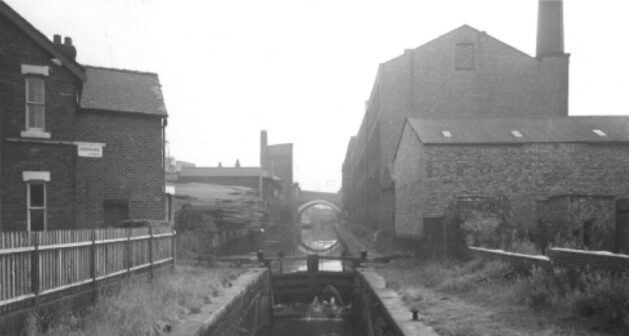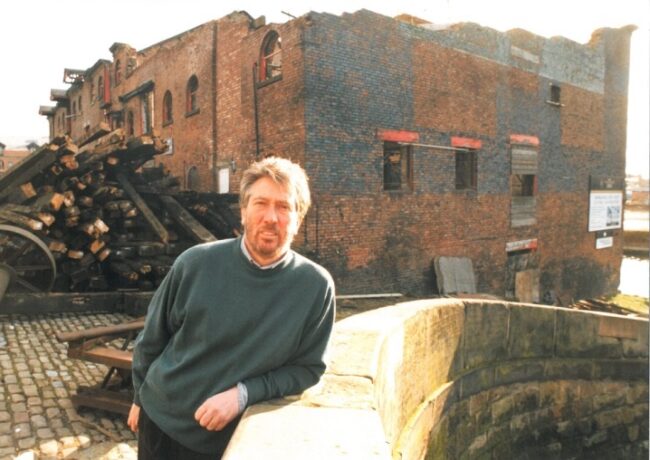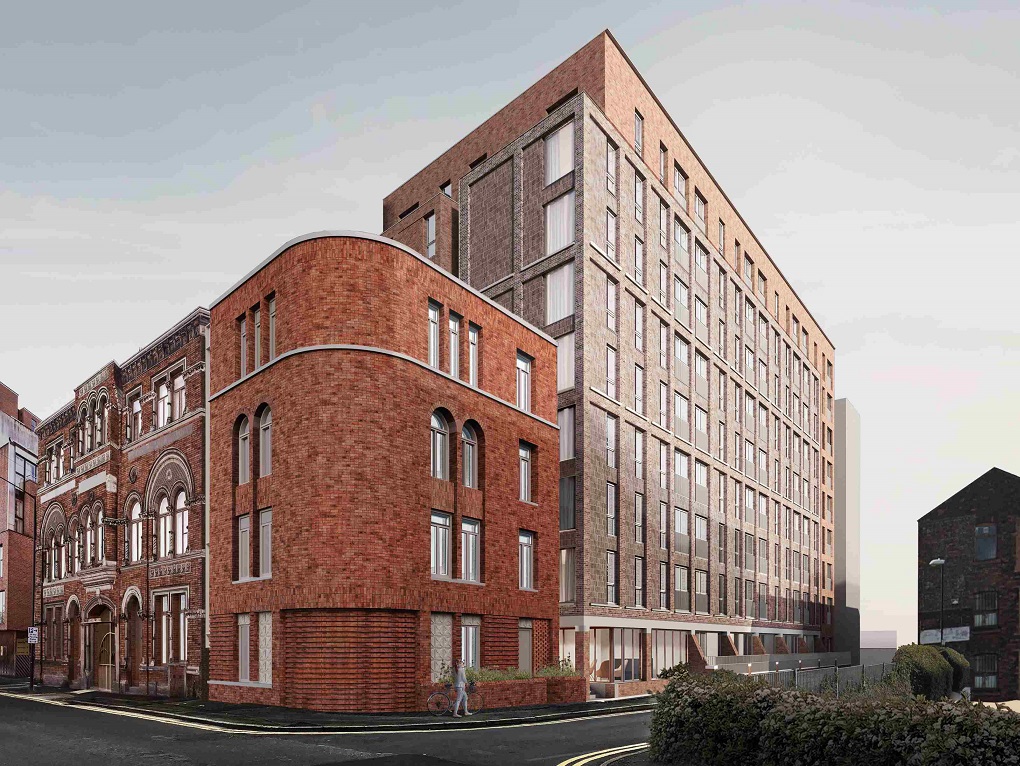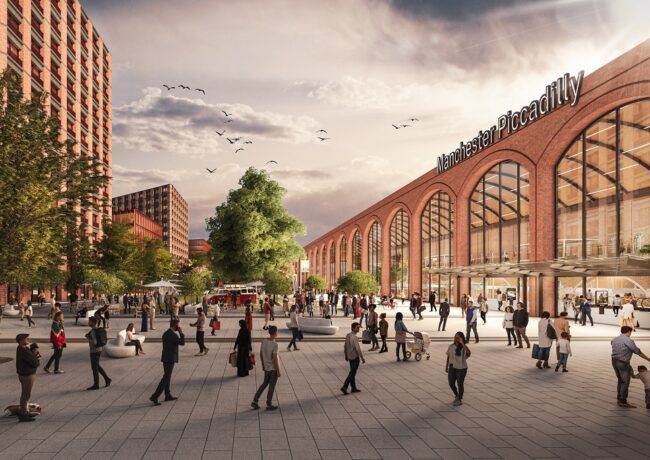TRIBUTE | The ‘remarkable’ Jim Ramsbottom
Jim had innate design sense and George Best flair and set about transforming Manchester’s Castlefield before anyone else did, writes Phil Griffin.
In 1984, I had friends who moved to a rented house at the bottom of a dark and dingy street of burnt-out sheds, car tyres and oil-filled potholes, improbably named Castle Street. They rented the rather lovely Lock Keeper’s cottage at the bottom, by the 92nd lock on the Rochdale Canal, in Castlefield Basin. Their landlord was a chain-smoking compact man with blush-red face and carefully cultivated hair that time-released dandruff to mingle with the ash on his well-cut lapels. He was Jim Ramsbottom, and he was a remarkable man.
Jim fetched items of surplus furniture from his small empire of betting shops, to help them set up home. He liked an audience, and often sat in the hall on the bottom stair, fag on, riffing on his far-ranging philosophy. Jim’s uncle Albert had a van and a shed in the wreck of the nearby Merchants Warehouse. Uncle Albert fed ducks on the water and kept an eye on Jim’s investments because, by now, Jim Ramsbottom owned the Gail and JS Bass warehouses on Castle Street, as well as Merchants and the coal yard stables opposite Lock Keeper’s.
Jim dreamt of transforming Castle Street into the Camden Lock Market of the North. Manchester City Council’s then-markets and street trading officer was having none of it. Markets were the council’s gig. Jim had no forward plan to develop his warehouse husks, until he met Nick Johnson, a Bolton lad from real estate agency Guest Shaw, who had just qualified in Urban Land Economics at Sheffield Poly. Nick was a keen canal boater, familiar with the Castlefield waterways. He saw the wharfs and warehouses, yards and coal drops, and wrote Jim a “flowery” five-page letter (Jim’s adjective), extolling their virtues and potential, if properly regenerated by good architects, and marketed using modern designs.
Jim had innate design sense (who knew from where?) and George Best flair (yes, Jim was a season ticket-toting thoroughbred Red). He read Nick’s letter and heard his pitch. He engaged architect Roger Stephenson (and disengaged him several times, across three decades of typical Jim turbulence) and graphics prodigy Trevor Johnson. They called the first building in the now-developed Castlefield district Eastgate. After litigation, liquidation, bankruptcies, sackings and Salford diplomacy, Eastgate finally completed in 1991. In the whole of that year there were virtually no commercial lettings in Central Manchester, save one: Eastgate fully let – two floors to Ocean Software, two to Centre Screen and sundry other “artsy-fartsy” types (Jim’s adjectives).

Pre-developed Castlefield, taken in the 1980s. c. Elle R Leisure
In 1981, Jim attended the auction of Raleigh Buildings on the Salford bank of the River Irwell at New Bailey. He didn’t get Raleigh, but he did spot a rat run by the river’s edge. He partnered with an old school pal, architect Dave Barnes of BDP, and fashioned a pub, The Mark Addy, memorialising a local hero who had rescued victims of a boating wreck. Jim’s wife Jean was landlady and sold beer and pâte to the habitual lunchtime clientele, from the courts, chambers, customs, accounting, print and television offices. The Mark Addy was a destination, with an outdoor terrace for globally warming days, and a model Jim would reintroduce a decade later, at Dukes92 in Castlefield.
Jim had decided to develop Castlefield because if not him, someone would come up from London and do it wrong. He engaged (disengaged and reengaged) the pantheon of late-century Manchester design-led architects Roger Stephenson, SimpsonHaugh, and OMI. Trevor Johnson (no relation to Nick) was go-to graphics. The late great Ralph Capper supplied furnishing. Oddly, for a man of vision, Jim did not see the market for city centre residential development. He lodged objections to most of it (including Castle Quay) on the basis that residents would complain about the noise of his passing pub trade, where office workers would not.
The development company Castlefield Estates and hospitality firm Elle R Leisure are Jim’s legacy. They are successful family-run businesses, and family (children and grandchildren) and business are what made the dainty (Nick Johnson’s adjective) all-swearing all-smoking Salford man tick.
Jim Ramsbottom put design, imagination and respect for the ideas of young people into the Manchester DNA. He had a temper, vanity and a vindictive twitch. There are those who will cringe, at some long-remembered barb, ill-tempered dismissal or financial stand-off. And there are those who will reminisce long into the night, recalling the ashtrays, the drinks, goals, near-misses and dismissals, praise and prejudice, remarks from the corner of the small smiling mouth, slow knowing wink and wave of a dainty hand to underscore a point as another hilarious and irrefutable discourse on urban reality is fluently laid out.
Jim Ramsbottom was no angel, but I would stand in a queue as long as Deansgate, just to be in his shining company a few moments longer.
Jim Ramsbottom, founder of Castlefield Estates, died last weekend aged 81.
Phil Griffin is an Ancoats-born freelance writer and curator of Pop Up Gallery





Nice words Phil
By Bob Allatt
Lovely words, what a legacy he leaves.
By Ollie
Beautiful tribute Phil. You have an enviable recall of the detail!
By Andy Spinoza
A lovely tribute that summed Jim up. He will be missed.
By Old Hack
Your last sentence expresses beautifully how many of us feel about Jim.
By Neil Rutledge
You’ve pretty much got him Phil.
Back in the day, his target tenant was the ‘pony tail brigade’, remember them?
I suspect Coogan’s Paul Calf character may have been based on Jim.
He would canvas opinion from all sorts, often applying greater weight and validity to the thoughts of his bin man over his long-suffering architect.
Phil O’Dwyer and OMI probably hold the record for somehow retraining Jim as a client over three decades. Eastgate (with Paul Iddon), Dukes’ 92 Phases 2 and 3, Bass Warehouse, Knott Mill offices and the refurb of Merchants. Phil also designed Jim’s House, a painful exercise indeed.
Developers that build for themselves demand much higher quality standards. Jim went further than most, and the legacy he leaves is there for all to witness. The Eastgate conversion is nearly 30 yers old, yet it still looks brand new.
RIP Jim
By Dave McCall
Beautifully captured Jim’s many shades and facets. He was a towering presence, by turns hilarious and terrifying. One-off doesn’t begin to cover and he will be missed.
By Phil O’Dwyer
A man before his time who saw an opportunity amidst all the grot at the time in Castlefield. Was the first part of the city centre where the word regeneration could be used
By Stephen Nicol
First met Jim when he popped into our office in Churchgate Housr on Oxford st
Our next door neighbour was the Urban Development Corporation charged with giving away £80 million pounds for urban regeneration in a swath of manchester which also included our detilict site that we owned on the corner of Oxford street and Whitworth st in Central manchester
We managed to attract nil in grants while Jim managed to lever millions from them
If there is one quality he had it is one of tenacity. And that is a quality successful entrepreneurs must have
Otherwise Phil I couldn’t jhave said it better
R I P Jim
By Danny samuels
A great character who I will miss. Many long conversations with Jim when working on Eastgate. I have a vivid memory of laughing until I was aching on my first and only time in a Rolls Royce trip to Bolton to look at materials for the project. Discussions in the offices on other occasions along with my partners in OMI – Phil O’Dwyer and Dave McCall that ran late into the evening with large volumes of tea and chain smoking. He loved talking about all things Castlefield and Manchester. But one particular focus was on the duckstone pavement at the back of what became ‘Albert’s Shed’. I still remember the look on his face when we proposed the angled entrance to Eastgate based on the historical line of the Roman Fort. Incredulity gradually replaced with enthusiastic nodding. This was topped off with an unprintable comment – something along the lines of ‘architect’s visceral passion for ideas being based on rather specific types of gratification’. He was hilarious. He could be a caution. He was mercurial. RIP Jim.
By Paul Iddon
Beautiful tribute Phil. I feel privileged to have worked for Jim as a young architect. He inspired and terrified me whilst at OMI. We all loved him. Working on Dukes 92, a project he was so passionate about, was an unforgettable experience. I used to frantically wave at his Rolls Royce years later, even on the M56. He always had time. A great legacy. He will be missed RIP Jim.
By Patrick Thomas
I have only recently become aware of the death of Jim Ramsbottom and would like to add my tribute to his contribution to the renaissance of Castlefield. On September 13th 1980 I was attending the River Irwell Rally on my narrowboat and whilst moored at Castlefield was asked if I would take some VIP’s down onto the river. Jim came on board and enjoyed the journey down the old Hulme Lock onto the Irwell, heading downstream we passed the “Westwood Ho” floating nigh club, the site of Pomona Docks and under Trafford Road bridge into Manchester Docks. We returned upriver to Hunts Bank below the Cathedral, passing the 140 boats moored on the river and the guests were finally put ashore at Albert Bridge. I am sure this experience started Jim’s interest in the regeneration of Castlefield and its waterways.
Graham Burns
Manchester Branch, The Inland Waterways Association.
By Graham Burns